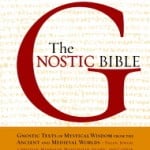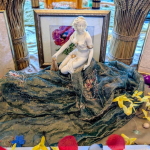After I posted my blog yesterday reviewing The Gnostic Bible, edited and translated by Willis Barnstone and Marvin Meyer, I thought I’d copy it to Marvin, since I was taking his name in vain, to see what he thought of it. As I was poking around, trying to figure out where I had stored his contact information, I came across his Wikipedia page, which had been updated, letting me know that he had passed over on August 16th of this year, from melanoma, the same cancer that took my brother a decade ago. Said page was short, far shorter than my page (which was put up by friends, not me), far shorter than Marvin deserved. Going looking for old friends on the Net and discovering that they had passed on not very long ago has become all too frequent these days.
Marvin’s death has hit me harder than I would have guessed. He was not just a colleague, but also a friend, one of the relatively few persons in the world who could understand my own passion for studying the Gnostics, as well as why I use novel writing to explore their implications for our own time. I was going to badger him (I typed “hymn” here. I am listening to the exquisite hymns of Hildegard of Bingen as I write. Seems like appropriate music for writing an obituary) to give me his uncensored opinion about my Goddess Murder, but I did not get around to that soon enough. Mea culpa.
I think I met Marvin soon after the publication of the first edition of the Nag Hammadi Library in English, the book that allowed the non-specialists (99.999…% of the human race) to read these astonishing documents for the first time, writings, rescued after 1500 years, by members of the other versions of Christianity that the Roman church annihilated. Marvin had been the managing editor for that project—which means that he did most of the grunt work on it that people who know nothing about how publishing actually works gave Jim Robinson credit for (of course, Jim deserves credit for masterminding the whole project and making the publication possible).
Someone who did not know Marvin would probably get the impression from that Wikipedia page, listing some of the books he wrote (well over a dozen), that he was just one of your run-of-the-mill boring college professors. Far from it. I remember one session at the Western Regional meeting of the American Academy of Religion, in Santa Clara in the early 80s, at which he gave us a slide show of the photos he had just taken in the “Villa of the Mysteries” in Pompeii, and how excited he was at having found parts of the fresco that had never been published. This is especially relevant for modern Witches, because the fresco depicts what is obviously an initiation ritual, and Gardner had included a photo of the central figure, a woman dancing ecstatically, in one of his books, with the comment that it resembled the initiation used in the Craft.
At a meeting of the AAR in Boston in the late 1980s, Marvin came up to me and asked if I would like to work with him on the translating of the Greek and Coptic magical manuscripts, which too had never been published in English. He said he felt that my extensive knowledge about things magical, ancient and modern, would be invaluable for the project. I was flabbergasted, but said “YES,” of course. I was trying to take it in, when Julie, my third wife, said to Marvin, “This is him being excited”—and Marvin laughed in a way that showed he understood such a reaction. I think he came to my presentation on “An Update on Neopagan Witchcraft in America,” based on data I had collected by analyzing news about covens in various Pagan periodicals, integrated with data from Gordon Melton’s research and from the latest edition of Margot Adler’s Drawing Down the Moon. It was subsequently included in a SUNY Press anthology on magical religions edited by Gordon. My presentation was well attended. Two of the most enthusiastic auditors were Leslie Philips and Linda Pinti, who had founded the Covenant of Uniitarian Universalist Pagans in 1985.
At that convention, Julie was walking about in the rather flamboyant red and black dress we had bought her for the occasion when two women came up to her and said, “We’re all wearing our pentacles on the inside. You’re wearing yours on the outside. Who are you?”
Julie replied, “I’m Aidan Kelly’s wife.”
They said, “Ah, well, that explains it.”
My old friend Gunder Hefta, who at that time was the Science Editor for Harvard University Press, also took us out for a fabulous dinner. I’ll have to write about him and Scientific American Books and suchlike at some later time.
Marvin sent me a copy of all the raw materials for the magical manuscripts project, but my life was falling apart rapidly at that time because of my illness, so I was never able to work on the project at all. Marvin got along perfectly well without me, and the book was published under the not very accurate title of Ancient Christian Magic (or something like that).At some point later on, I asked him if I could list him as a reference in applying for some sort of position with one of Chapman’s outposts. He said, “Of course!” But nothing came of that.
Marvin was not hostile to official Christianity nor interested in apologizing for its shortcomings. He analyzed the objective implications of the Gnostic and related writings, and left it up to the churches to bite the bullet and face the facts. He was able to write so many books because he had won his faculty position at Chapman University, which he thoroughly deserved to have, despite the fierce competition for such posts that had developed in American academia by the late 1970s. When I met him, we were the young Turks. Gradually we became the old Turks, and now, one by one, we are becoming the ex-Turks, as is inevitable. One must accept the inevitable, but one does not have to like it.
















